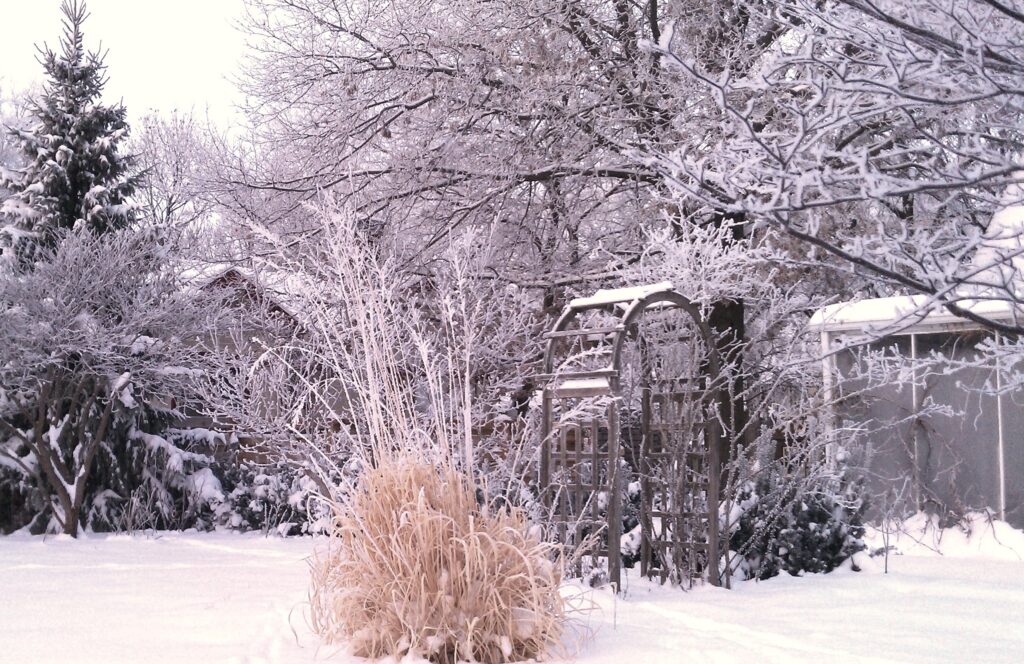
Putting your garden to bed properly at the start of winter gets you ready for spring and one step closer to having a good spring garden.
Protect New Trees
If you’ve planted new trees, especially fruit trees, wrap them with a protective tree wrap or chicken wire. It prevents rabbits and rodents from nibbling the tasty bark and can minimize damage from deer rubbing up against it. Wrap has the added bonus of preventing sun scald, which happens when there are warm, sunny winter days followed by a cold snap, damaging the bark. Remove wrap in spring.
Provide a Blanket of Fluffy Mulch
Perennials and strawberries do best with 1 to 4 inches of a loose, removable mulch over and/or around them. A light, airy mulch serves as a blanket to protect smaller, shallow-rooted plant from the extremes of sun and cold and frost cycles, which can heave some plants right out of the ground. If you have evergreen boughs, those are excellent. So are leaves chopped by running a mower over them. You can use straw, but it often distributes seeds into the flowerbed. Gently remove the mulch in spring when plants start to send out new growth, which is usually early March in Iowa.
Protect Roses
Most roses are an iffy proposition in Iowa, but you can greatly increase their chances of making it through the winter. First, avoid cutting back roses in the fall. Roses tend to survive the winter better with as much of their plant material intact as possible. However, if there are long canes that will whip in the wind, go ahead and cut them back somewhat.
Never use those white cones. They can actually be harmful to roses and besides, they’re not very attractive.
Before the first snowfall, you can further protect roses by mounding them. That is, mound 8-12 inches of compost or rich, dark soil to protect the bud union (right above the roots) from winter cold.
For rugosa and Candian Explorer roses, mounding is probably enough. For other types—esepcially hybrid teas, grandiflora, and floribunda rose, which are the least cold hardy types—consider wrapping them in burlap and twine. Other gardeners create chicken wire cylinders around them and fill the cylinders with chopped autumn leaves.
Shelter Tender Plants Indoors
If you have tender plants that are perennials in warmer climates, you can experiment with bringing them indoors for the winter. Before the first frost (usually in mid-October), dig them up, put them in ports, and bring them indoors into a sunny spot.
Hibiscus, jasmine, rosemary, citrus trees, and others will often survive the winter if brought indoors. Adequate light is critical, so consider grow lights. Equally critical is protection from drafts, which can cause brown tips, leaf drop, and other problems. Adequate humidity is also important. Invest in an inexpensive humidity monitor to see how low or how high the humidty level is around your plants. The ideal is around 60 percent and should never be below 40 percent (which isn’t particularly good for humans, either.) If humidity is low, consider running a humidifier. Or set the plants on a tray filled with pebbles and water to increase humidity around the plant. It can also conserve humdity and help the plant overall to keep it a room that is as cool (but not freezing) as possible, ideally around 50 degrees.
One of the most popular plants to overwinter is annual geraniums (Pergolarium). Bring them indoors in pots to keep under a grow light. Or remove them from the pots, shake the soil off the roots, and store in a cool place, such as a cool basement, in a paper bag until spring. Pot up and cut stems back by about two-thirds.
Water Your Evergreens
If the fall has been dry, water plants, especially evergreens and trees and shrubs, planted less than a year ago. Even this time of year, plants still need adequate moisture. Otherwise, they might go into winter dehydrated and stressed, making them more likely to die out by spring.
Clean And Store Tools And Equipment
Clean up your garage or tool shed so that everything is ready to go for spring. Clean, sharpen, and oil tools as needed. Take advantage of end-of-season sales for potting soil, fertilizer, and other garden supplies.
Drain your gas-powered tools (such as mowers, blowers and trimmers) of gas and oil. Follow the manufacturer’s recommendations for storing them over winter. Make a note in your calendar to have any dull blades sharpened sometime in winter.
Remove batteries from any power tools, including mowers, and store in a non-freezing area.
Detach garden hoses to prevent burst outdoor faucets. Drain and store in a sheltered place.
If you have a rain barrel, empty it and store it in a sheltered place.
You may also be interested in:
Please do not use content from this site without express permission from The Iowa Gardener. Click here to request permission.